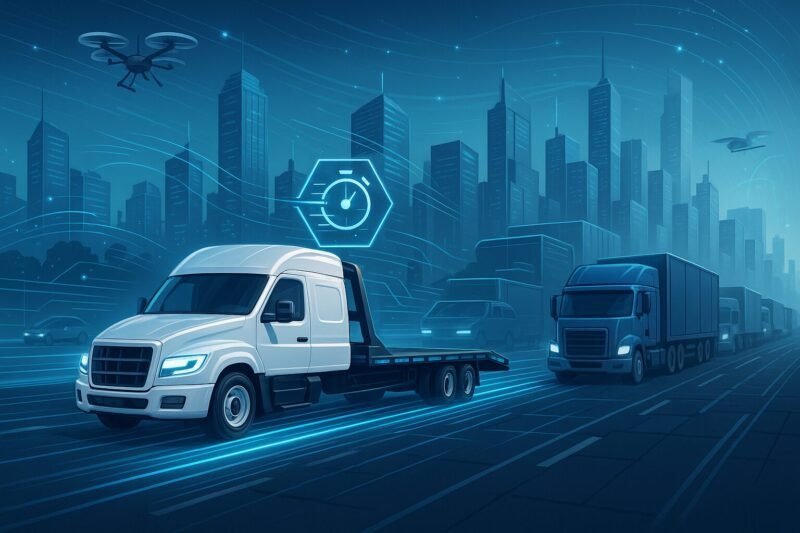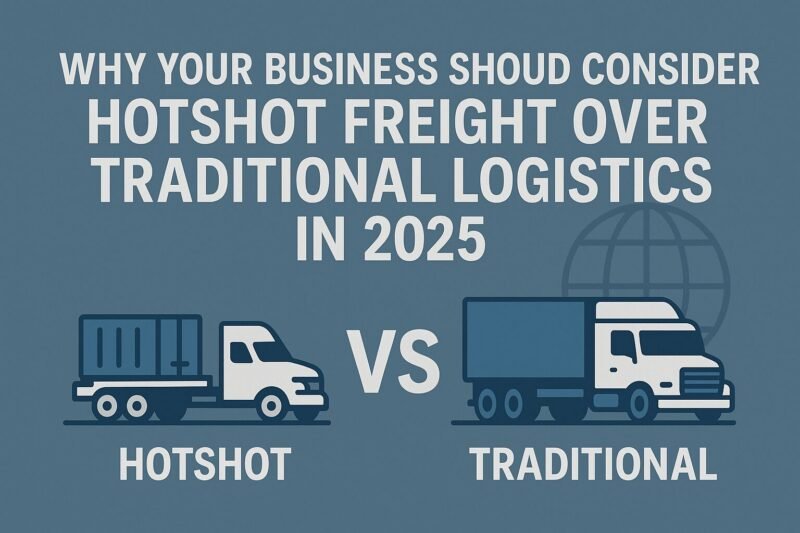The logistics landscape is experiencing a seismic shift as we advance through 2025. While traditional freight methods have dominated supply chains for decades, hotshot freight services are emerging as a game-changing alternative that addresses the evolving needs of modern businesses. This comprehensive analysis explores why forward-thinking companies are increasingly choosing hotshot freight over conventional logistics solutions.
Understanding Hotshot Freight: The Modern Logistics Solution
Hotshot freight represents a specialized transportation service that utilizes smaller, more agile vehicles—typically pickup trucks with trailers—to deliver time-sensitive cargo. Unlike traditional logistics that rely on large semi-trucks and rigid scheduling, hotshot operations offer unprecedented flexibility and speed for businesses requiring immediate solutions.
The term “hotshot” originates from the oil and gas industry, where urgent equipment deliveries were critical to operations. Today, this service model has expanded across industries, becoming a cornerstone of agile supply chain management in 2025’s fast-paced business environment.
The Traditional Logistics Challenge in 2025

Traditional logistics systems, while reliable for large-volume shipments, face significant limitations in today’s market. These conventional methods typically involve consolidated freight, fixed routes, and standardized delivery schedules that often fail to meet the dynamic requirements of modern businesses.
The challenges become particularly apparent when considering the average lead times for traditional freight. Standard LTL (Less Than Truckload) shipments often require 3-7 business days, while FTL (Full Truckload) services, despite being faster, come with high costs for smaller shipments and limited flexibility for route modifications.
Moreover, traditional logistics providers in 2025 continue to struggle with the last-mile delivery challenges, capacity constraints during peak seasons, and the increasing demand for real-time tracking and communication that today’s businesses expect.
Speed and Efficiency: The Hotshot Advantage
The primary differentiator of hotshot freight lies in its exceptional speed and efficiency. While traditional logistics systems require time for consolidation, sorting, and hub-based routing, hotshot services provide direct, point-to-point delivery with minimal delays.
In practical terms, hotshot freight can reduce delivery times by 50-70% compared to traditional methods. A shipment that might take five days through conventional logistics can often be delivered within 24-48 hours via hotshot services. This speed advantage becomes crucial for businesses dealing with production downtime, emergency repairs, or time-sensitive customer commitments.
The efficiency extends beyond mere speed. Hotshot operators can navigate routes that larger trucks cannot access, deliver to remote locations, and provide door-to-door service without the multiple handling points that increase risk and delay in traditional systems.
Cost Analysis: Breaking Down the Economics
The cost comparison between hotshot freight and traditional logistics reveals surprising insights that challenge conventional assumptions. While hotshot services may appear more expensive on a per-mile basis, the total cost of ownership often favors the hotshot approach when factoring in all variables.
Traditional logistics costs include not only transportation fees but also inventory carrying costs, warehousing expenses, and the hidden costs of delayed deliveries. When a critical component delays production, the resulting downtime costs can far exceed the premium paid for hotshot delivery.
For example, a manufacturing company facing a production line shutdown due to a missing part might lose $10,000 per hour in productivity. In this scenario, paying an additional $500 for hotshot delivery versus waiting two days for traditional freight represents a 95% cost savings.
Additionally, hotshot freight eliminates many ancillary costs associated with traditional logistics, including terminal handling fees, fuel surcharges applied to consolidated shipments, and detention charges for delayed pickups or deliveries.
Flexibility and Customization: Meeting Unique Business Needs
The modern business environment demands logistics solutions that can adapt to changing requirements, and this is where hotshot freight truly excels. Unlike traditional carriers with rigid pickup and delivery windows, hotshot operators offer 24/7 availability and can accommodate urgent schedule changes.
This flexibility proves invaluable for businesses in sectors such as oil and gas, construction, manufacturing, and automotive, where project timelines frequently shift and emergency deliveries become necessary. Hotshot services can provide dedicated vehicles for specific loads, ensuring that shipments receive individual attention rather than being part of a consolidated load with multiple stops.
The customization extends to handling requirements as well. Hotshot operators can provide specialized equipment for oversized loads, temperature-controlled transport, or hazardous materials shipping, often with shorter notice periods than traditional carriers require for similar services.
Technology Integration and Real-Time Visibility
As businesses increasingly rely on data-driven decision making, the technology integration capabilities of logistics providers become paramount. Hotshot freight services in 2025 leverage advanced tracking systems, mobile applications, and real-time communication platforms that often surpass the technological offerings of traditional logistics providers.
Modern hotshot operations utilize GPS tracking, electronic logging devices, and mobile apps that provide customers with live updates on shipment location, estimated arrival times, and delivery confirmations. This level of transparency enables better planning and reduces the uncertainty associated with critical shipments.
The smaller scale of hotshot operations also allows for more personalized communication. Customers can often communicate directly with drivers, receive photo confirmations of pickups and deliveries, and obtain immediate updates on any route changes or delays.
Environmental Considerations and Sustainability
The environmental impact of logistics operations has become a critical consideration for businesses in 2025, and hotshot freight offers several sustainability advantages over traditional methods. The smaller vehicles used in hotshot operations typically have lower emissions per shipment, especially when considering the reduced number of empty miles and the elimination of multiple handling points.
Hotshot freight also reduces the overall carbon footprint by eliminating the need for intermediate warehousing and consolidation centers. Direct delivery routes mean fewer miles traveled and reduced fuel consumption compared to the hub-and-spoke model of traditional logistics.
For companies with sustainability goals and ESG commitments, choosing hotshot freight for appropriate shipments can contribute to their environmental objectives while maintaining operational efficiency.
Industry-Specific Applications and Success Stories
Different industries have found unique value propositions in hotshot freight services. In the oil and gas sector, hotshot delivery of critical equipment can prevent costly production shutdowns. Construction companies rely on hotshot services to deliver materials and tools to remote job sites where traditional trucks cannot access.
The automotive industry has increasingly adopted hotshot freight for delivering prototype parts, replacement components, and time-sensitive materials to assembly plants. Similarly, the aerospace sector utilizes hotshot services for transporting high-value, lightweight components that require careful handling and rapid delivery.
Healthcare organizations have found hotshot freight invaluable for transporting medical equipment, laboratory samples, and pharmaceuticals that require temperature control and rapid delivery to maintain efficacy.
Challenges and Considerations
While hotshot freight offers numerous advantages, businesses must also consider potential limitations. The capacity constraints of smaller vehicles mean that hotshot services are most effective for shipments under certain size and weight thresholds, typically loads that can be handled by pickup trucks with trailers.
Weather conditions can impact hotshot operations more significantly than traditional freight, as smaller vehicles may be more susceptible to adverse conditions. Additionally, the specialized nature of hotshot services means that capacity may be limited during peak demand periods.
Businesses should also evaluate their shipping patterns to determine when hotshot freight provides the greatest value. Regular, high-volume shipments between fixed locations may still be more cost-effective through traditional logistics, while irregular, urgent, or destination-flexible shipments are ideal candidates for hotshot services.
The Future Landscape: Hotshot Freight in 2025 and Beyond
As we progress through 2025, several trends are shaping the future of hotshot freight. The integration of electric vehicles into hotshot fleets is beginning to address range limitations while providing even greater environmental benefits. Autonomous vehicle technology, while still developing, promises to further enhance the efficiency and availability of hotshot services.
The growth of e-commerce and the increasing expectation for rapid delivery are driving demand for hotshot services beyond traditional industrial applications. Last-mile delivery solutions are incorporating hotshot methods to reach customers in remote areas or provide same-day service in urban markets.
Digital platforms and marketplace models are making hotshot services more accessible to smaller businesses, democratizing access to premium logistics services that were previously available only to large corporations with dedicated transportation contracts.
Making the Strategic Decision: When to Choose Hotshot Freight
The decision to incorporate hotshot freight into a logistics strategy should be based on a comprehensive evaluation of business needs, cost considerations, and operational requirements. Businesses should consider hotshot freight when dealing with time-sensitive shipments, emergency deliveries, remote or hard-to-reach destinations, and high-value or specialized cargo.
The ideal candidates for hotshot freight are companies that experience significant costs from delays, operate in industries where downtime is expensive, or serve customers who value speed and reliability over cost minimization. Additionally, businesses with irregular shipping patterns or those requiring flexible scheduling find the greatest benefit from hotshot services.
Conclusion: Embracing the Future of Logistics
The logistics landscape of 2025 demands solutions that can adapt to the rapid pace of modern business while providing the reliability and service quality that customers expect. Hotshot freight represents a strategic alternative to traditional logistics that addresses many of the pain points businesses face with conventional shipping methods.
While not appropriate for every shipment or every business, hotshot freight offers compelling advantages in speed, flexibility, customer service, and total cost of ownership for the right applications. As businesses continue to prioritize agility, customer satisfaction, and operational efficiency, hotshot freight services are positioned to play an increasingly important role in comprehensive logistics strategies.
The key to success lies in understanding when and how to leverage hotshot freight as part of a diversified logistics approach. Companies that embrace this flexibility and integrate hotshot services strategically will find themselves better positioned to meet customer demands, respond to market changes, and maintain competitive advantages in an increasingly dynamic business environment.
By carefully evaluating their specific needs and comparing the total value proposition rather than just transportation costs, businesses can make informed decisions about incorporating hotshot freight into their logistics operations. As we move forward in 2025, the companies that thrive will be those that choose the right logistics solutions for each situation, leveraging the unique advantages that hotshot freight provides when speed, flexibility, and reliability are paramount.
